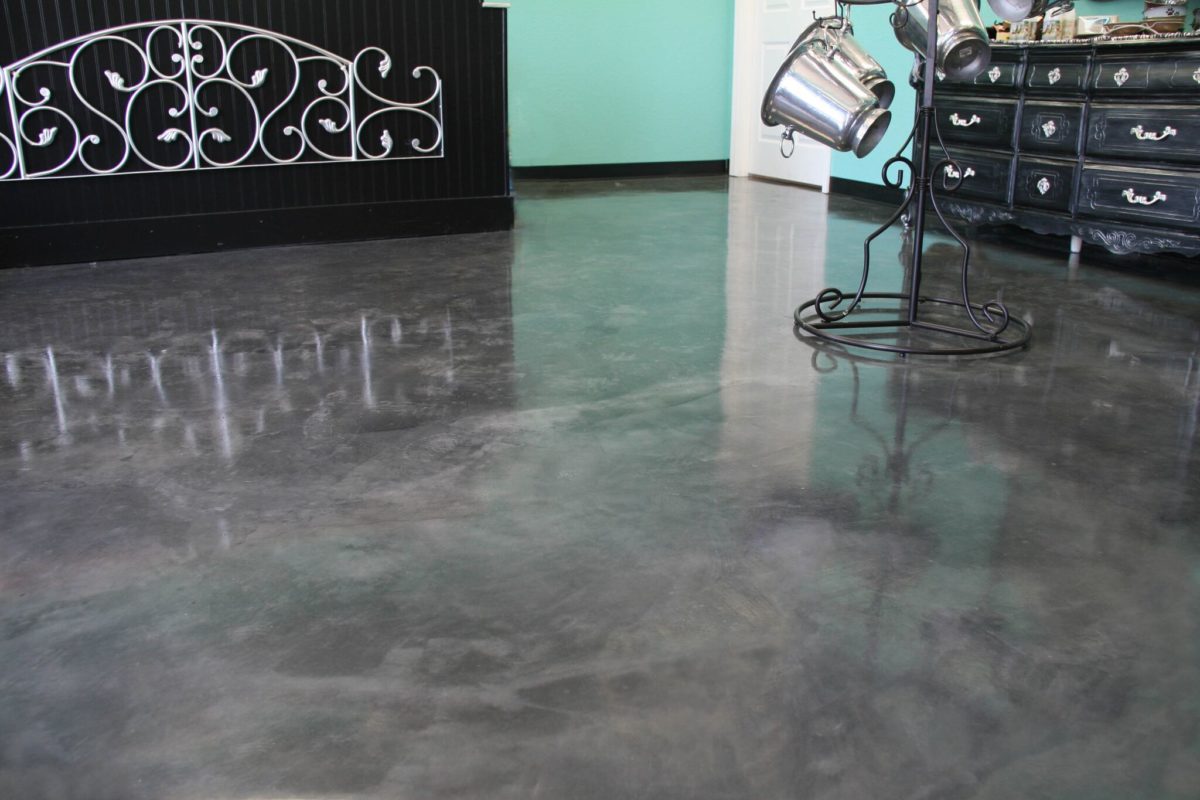This post on the difference between concrete acid-stains and water-based stains is a supplement to our main post on how you stain concrete.
Summary
What is the difference between concrete stain and acid stain?
Acid-based stains
Acid-based concrete stains interact with the ‘cream’ or top layer of concrete which is a fraction of an inch thick. The reaction with the minerals in the concrete leaves a permanently bonded color that will not chip or peel but must be clear-coated later. Acid stains create a swilling look that is highly desirable and found in many high-end homes. It works on untreated concrete, even if it has a tint, such as the common terra-cotta look. Of course, this will factor into your final color. Always do a test spot! These require a clear coat finish.
Water-based stains
These are much easier to apply and does not require clear-coating like acid-based concrete stains. They also come in more colors. Much less preparation is required and it leaves an even, paint-like color. There is some staining of the concrete, but much of the color comes from acrylics that bond to the top of the slab, like paint.
The full details Water Based Concrete Stain vs. Acid Stain
Acid-based stains…
- don’t fade or peel like paint. There was a time all concrete stains used dyes in alcohol, etc and always faded even without sun.
- come many warm, earthy tones and can be mixed to create an infinite variety.
- intentionally leave inconsistencies in the slab: a variegated or mottled appearance, which is subjectively very attractive.
- is compared to, and tries to simulate granite or marble.
- is often used in very ‘high-end’ (meaning expensive) homes.
- require a clear-coating to bring out the depth and to protect the color (and for protection).
The clear-coat I recommend in my main post on staining concrete is one that when needed, does not require any sanding. It re-emulsifies and bonds very well. I recommend (in that post) a top-flight company that makes the full range of products that all play nice together: from prep solutions to the sealant.
Acid concrete staining is a chemical reaction penetrates and changes the actual chemical makeup of the minerals in the slab up to 1/16 inch deep, unlike water-based stains that fill the concrete’s pores and leave a film, somewhat like paint.
Acid stains are made up of metallic salts in an acid and water mix that stain the concrete. The result is random, translucent swirls. The look has deep tones and a simulated marbling look.
Water-based stains…
- are user-friendly and very safe.
- as easy to apply as paint.
- are available in a wider variety of colors.
- generally require less prep than acid-based stains.
They do not have to be clear-coated (in fact the makers often recommend that you do not clear coat them).
Prep and Application Differences
The prep for acid-based stains must never include muriatic acid etching or grinding, but this is an option for water-based stains. (Some thinkers in the world of paint don’t like the idea of acid-etching, others do. It’s only used to create a roughness “profile” that can accept the coating of your choice: water-based stain, epoxy, paint, etc.
Application methods are not very similar: the acid-based stain needs time to react and darkens with reaction time. Then the acid must be neutralized and rinsed and then sealed. Water-based just dry and that’s it.
The water-based stain goes into the open pores of the concrete somewhat: but it’s also like paint in that it leaves a film or coating on top. No chemical reaction takes place. However, in time, the stain could crack, unlike the acid stain.
Toxicity
Water-based stains are generally low in VOCs (volatile organic compounds) which is a dangerous compound (I have written about VOC’s here). This is not essential reading, but good to keep in mind for life.
If you want a respirator, I simplified the complex world of filters respirator filters and masks here.
I wear the half-mask with the layers of filters that are interchangeable. These are all found in this starter kit.
After they cure, acid-based stains are as safe as any cured paint. The VOCs they give off while curing are all gone, so always apply and allow to dry and cure with steady ventilation.
That’s it.
Now back to the details of concrete stain. It contains our favorite products and the ‘how-to’ steps for each type of concrete stain.

I used Valspar semi-transparent on my new (3 month old) screened porch slab. I love the color. But then Valspar suggested I cover it with their protective sealer and I chose the natural low-gloss.
They didn’t tell me the stain itself was going to seal the slab well enough! Now I see where you mention that here. But as ALL the negative valspar reviews say (that I didn’t see before), the floor is now super slick! It is 100% acrylic AND is “silicone infused”. And it feels like silicone on our shoes and it tracks into our house and on our wood deck!
What is the easiest way to remove this junk sealer? Our porch is almost like an indoor room and there are certain things we can’t do. We can hose it off, but it’s elevated and it will all wash down a painted block foundation wall, so harmful stuff could ruin the DryLock wall paint. Power sanding and grinding will not be nice for the area either. I’d like it to not ruin the floor stain, but if I have to re-stain I can.
If there was a way to just clean it or degrease it enough so that people won’t slip and it won’t track stuff into the house that would be nice. Like a way to just undo the silicone effect. I’m so mad valspar has done this to me!
I’ve tried purple (industrial) Zep on it and there is no difference. I started to sand a small corner and it’s going to leave white scratches. What should we do?
Thanks!
Grab some paint remover and see how that works. There is a citrus paint remover and a more toxic old fashion paint remover. Be sure to protect your breathing and your lungs when you use the toxic stuff. Also, acetone might remove the top layer but I’m not sure. That’s extremely toxic also so be careful. Full reply coming soon.
Brad